|
|
|
Bissone |
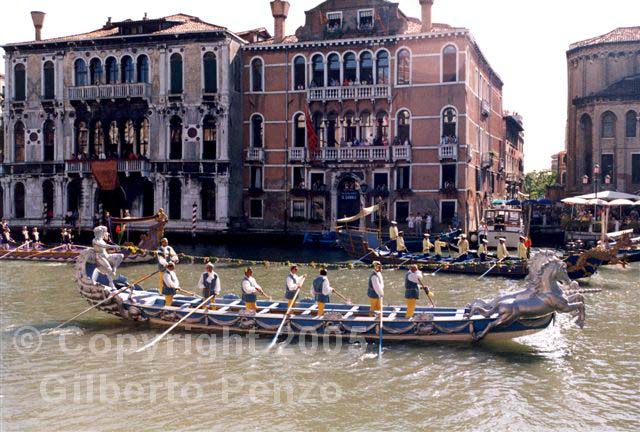 |
|
Bissona
"Cavalli"
|
Antica
imbarcazione veneziana da parata, vogata da otto rematori
in costume, fastosamente addobbata con sculture e intagli
dorati secondo un tema allegorico. Era utilizzata per
sfilare o accogliere personaggi importanti. Tuttora dieci
di queste imbarcazioni, ricostruite, da Giovanni Giuponi
formano il corteo acqueo durante la Regata Storica.
Vai
a: disegni
di bissone
The
Bissóna is an ancient Venetian ceremonial boat,
rowed by eight oarsmen in costume, lavishly decorated with
allegorical sculptures and gold-plated carving. It was used
in parades or to welcome important people. Ten of these
boats, reconstructions built by Giovanni Giuponi, still form
the canal procession during the Regata Storica.


Bissona
"Geografia"
Bissona
"Serenissima" |
|
|
|

Bissona
"Veneziana" |
|
|
|
Peote,
pedote e peatoni
|
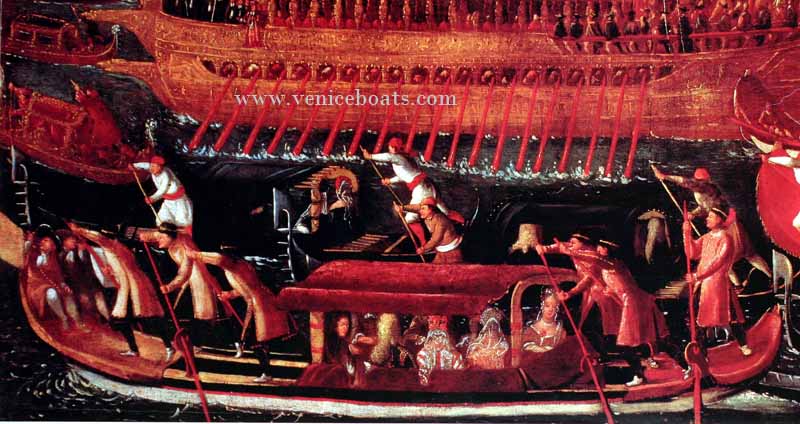 |
|
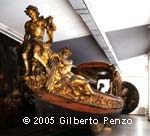
Peota
Savoia vista di fronte |
Imbarcazione
da parata e diporto per passeggeri di rango elevato,
condotta da otto vogatori.
Era
dotata di cabina o tiemo
centrale per la protezione degli ospiti, decorata come lo
scafo e l'equipaggio, a tema e più o meno sfarzosamente
secondo il ceto sociale dei proprietari.
Si usava per gite in laguna,
per assistere alle regate, per accogliere ospiti illustri
e per seguire le cerimonie dogali che si svolgevano
sull’acqua.
Vai alla pagina
della Peota
Savoia
This was
a ceremonial boat also used as a pleasure boat for
high-ranking passengers, rowed by eight oarsmen. It had a
central cabin, tiemo, to shelter the guests, which
was decorated with the same theme as the hull and the crew,
more or less gaudily depending on the social class of the
owners. It was
used for trips on the lagoon, to see the regattas, to
welcome illustrious guests and to follow the ceremonies of
the doge.
Peota
Savoia
Ceremonial boat built in 1730
made to the order of Carlo Emanuele III di Savoia,
King of Sardinia, in a boatyard on Burano; it was then
transported together with a number of gondolas upstream
along the river Po to the castle of Valentino di Torino,
for the enjoyment of the royal family. Kept at the Museo Civico di
Palazzo Madama in Turin, it is now awaiting restoration by
the company Nicola Restauri in Aramengo, Piedmont.
Main
dimensions:
hull
length
approx. 15,57
m
beam
approx. 2,8
m
depth
approx. 0,96
m
number
of oarsmen 8 |
|
|
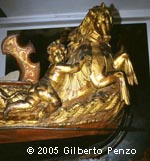 |
|
|
|
|
|
|
|
Bucintori
|
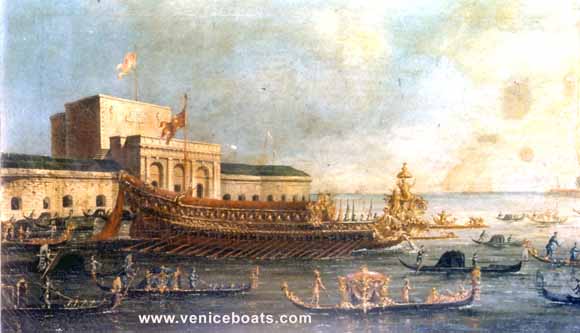
Il Bucintoro settecentesco
durante la cerimonia dello Sposalizio del mare presso il
Forte di S. Andrea. Museo Storico Navale di Venezia. The eighteenth century bucintoro
during the ceremony of the Wedding of the Sea at Forte di S.
Andrea. Venice Museum of Naval History. |
 Bucintoro quattrocentesco
tratto dalla pianta di Venezia di Jacopo de Barbari. Fifteenth century bucintoro
from the view of Venice by Jacopo de Barbari.
Bucintoro quattrocentesco
tratto dalla pianta di Venezia di Jacopo de Barbari. Fifteenth century bucintoro
from the view of Venice by Jacopo de Barbari. |
|
La più ricca tra le imbarcazioni
da parata veneziane, utilizzata dal Doge e dalle massime
cariche dello Stato per partecipare alle cerimonie
ufficiali come lo “sposalizio del mare” o per
accogliere re e ambasciatori stranieri.
Più che di bucintoro bisogna
parlare di bucintori al plurale, dati i numerosi scafi che
si sono succeduti nel corso dei secoli: da quello
costruito nel 1449, sotto il doge Francesco Foscari, che
però non fu il primo visto che fu fatto: mazzor di
quello che era l’altro. Ve ne fu un’altro varato
nel 1526, rimpiazzato a sua volta, nel 1606 da un
nuovo esemplare sotto il doge Leonardo Donà. L’ultimo
bucintoro fu varato 12 gennaio 1728, sotto il dogato di
Alvise Mocenigo e finì distrutto dagli occupanti francesi
alla caduta della Serenissima Repubblica.
Di tutti questi scafi non
rimangono che poche immagini, alcuni modelli e frammenti
di dubbia attribuzione, e, come per tutte le barche e
navi nessun disegno tecnico; anche i bucintori, infatti,
era costruiti solo con l’uso
dei sesti andati perduti.
Tutti gli scafi di cui abbiamo
notizia erano caratterizzati da una struttura a due ponti,
l’inferiore per i vogatori e il superiore per i
passeggeri, il tutto decorato nella maniera più sfarzosa
possibile con dipinti, intagli, intarsi e sculture fra cui
troneggiava a prua Venezia nelle vesti di “giustizia”
con spada e bilancia.
Le dimensioni dell’ultimo
bucintoro erano:
Lunghezza in colomba
(chiglia) 100 piedi veneti pari a 34,8 m, larghezza e. f.
21 piedi veneti pari a 7,30 m
La sala principale ricoperta dal tiemo
grande era lunga 22,6 m, quella piccola riservato al Doge
8,51 m.
C’erano 21 portelli per
lato, da cui fuoriuscivano i remi lunghi 32 pv (10,80 m)
mossi ognuno da quattro arsenalotti.
Articolo su:
Arte navale, agosto-settembre 2000. Gilberto Penzo, La reggia sulle acque,
Ricostruzioni del Bucintoro
del Terzo Millennio
Modelli
bucintoro, Progetti bucintoro.
Foto
Modello Museo Storico navale
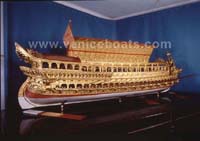
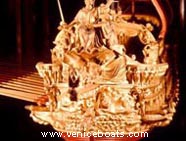 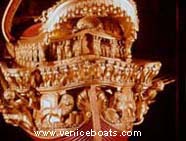
Vista laterale frontale e
poppiera del modello di Bucintoro conservato al Museo
Storico Navale di Venezia.
|
|
|
|
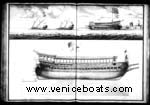 Vista laterale, sezione e
pianta del Bucintoro secentesco, e lo stesso rimorchiato
da due galee fuori dal porto di Venezia, immagine tratta
dal manoscritto A voyage into the Mediterranean Seas, di E.
Dummer del 1685, British Library, King's mss. 40.
Vista laterale, sezione e
pianta del Bucintoro secentesco, e lo stesso rimorchiato
da due galee fuori dal porto di Venezia, immagine tratta
dal manoscritto A voyage into the Mediterranean Seas, di E.
Dummer del 1685, British Library, King's mss. 40.
Side view, section and plan
view of the seventeenth century bucintoro; the bucintoro
being towed by two galleys. Taken from the manuscript A voyage into the Mediterranean Seas,
by E. Dummer 1685, British Library, King's mss. 40. |
|
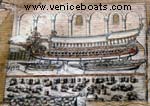 Il Bucintoro nella sua tesa
prima dell'arrivo dei soldati francesi, assieme ad una
felucca e ad un caichio dorato. Pianta dell'abate
Maffioletti, Museo Storico Navale di Venezia. The bucintoro in its
tesa (yard), together with a felucca and a
guilded caicho, before the arrival of French
soldiers. Drawing by the Abbot Maffioletti, Venice Museum of
Naval History.
Il Bucintoro nella sua tesa
prima dell'arrivo dei soldati francesi, assieme ad una
felucca e ad un caichio dorato. Pianta dell'abate
Maffioletti, Museo Storico Navale di Venezia. The bucintoro in its
tesa (yard), together with a felucca and a
guilded caicho, before the arrival of French
soldiers. Drawing by the Abbot Maffioletti, Venice Museum of
Naval History. |
|
|
|
|
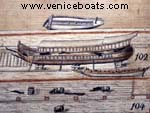 Lo stesso dopo la spogliazione
delle decorazioni ad opera dei soldati di Napoleone.
Pianta dell'abate Maffioletti, Museo Storico Navale di
Venezia.
Lo stesso dopo la spogliazione
delle decorazioni ad opera dei soldati di Napoleone.
Pianta dell'abate Maffioletti, Museo Storico Navale di
Venezia.The bucintoro after
being stripped of its decorations by Napoleon's soldiers.
Drawing by the Abbot Maffioletti, Venice Museum of Naval
History. |
|
|
The most magnificent vessel of
Venetian ceremonies, the bucintoro was used by the
doge and the highest offices of the State to participate in
official ceremonies such as the 'wedding with the sea' or to
welcome foreign kings and ambassadors.
It
would be more correct to use the plural term 'bucintori'
rather than the singular 'bucintoro' given
the number of boats over the centuries that have been given
the name: from the one built in 1449 under the doge
Francesco Foscari, which, however, was not the first as it
was made 'larger than the original'. Another was launched in
1526, replaced in turn in 1606 by a new type under doge
Leonardo Donà. The last bucintoro was launched on the 12th
January 1728 under the doge Alvise Mocenigo and was
destroyed by French soldiers at the fall of the Most Serene
Republic.
Of
all these vessels all that remains are a few pictures, some
models and a few fragments of dubious authenticity, and, as
is the case for all boats and ships, there are no technical
drawings. In fact even the bucintori were built using
sesti (templates) which were lost.
Each of the vessels we know about
was characterized by a two-deck structure, the lower deck
for the oarsmen and the upper deck for the passengers, the
whole boat decorated in the most gaudy way possible with
paintings, carvings and sculptures including, at the bow,
the figure of Venice with sword and scales.
The
dimensions of the last bucintoro were:
Keel length 100 Venetian feet (
34.8 m), beam 21 Venetian feet 7.30 m
The main hall covered by the tiemo
was 22.6 m long while the smaller one reserved for the doge
was 8.51 m long.
There were 21 hatches on
each side from where the oars (10.8 m long) extended. Each
oar was rowed by four men from the Arsenal |
|